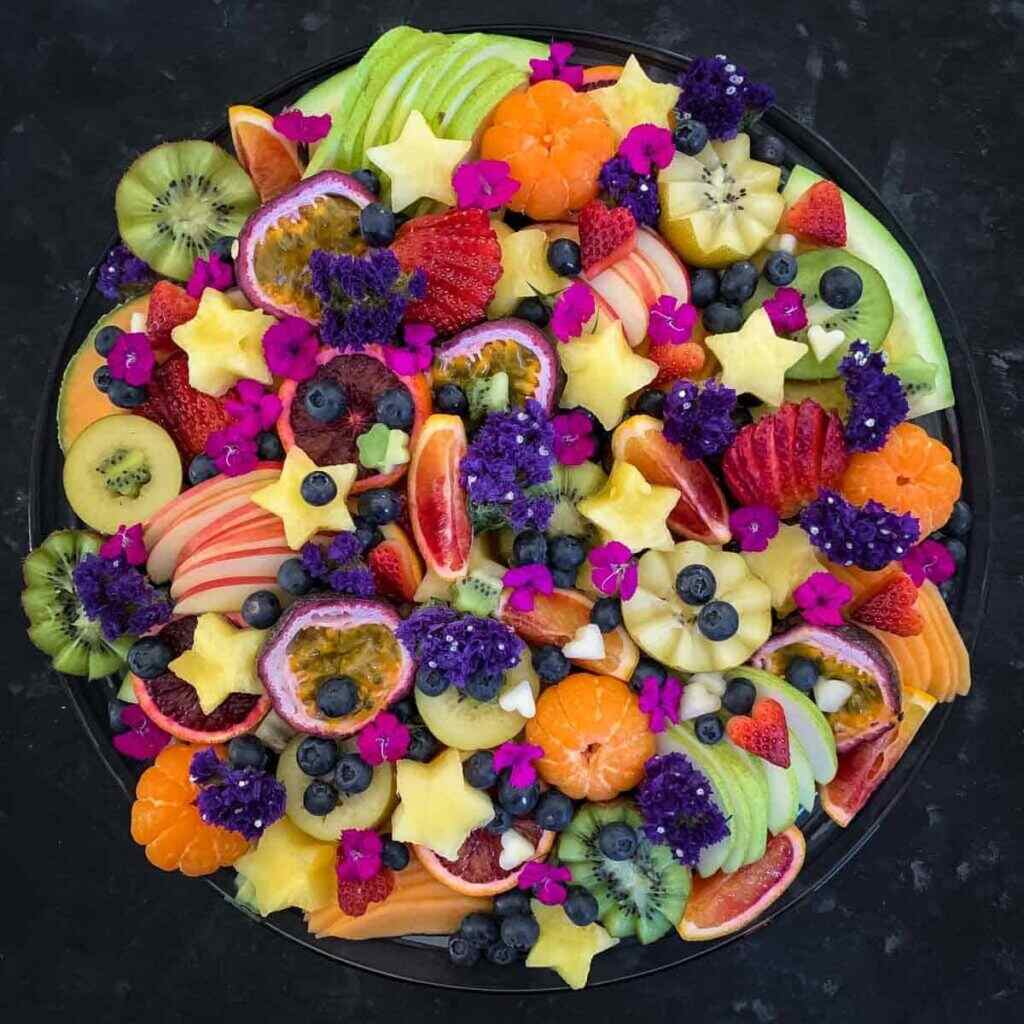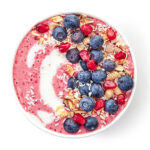A fruit salad platter is a visually appealing and tasty arrangement of fresh, ripe fruits. This delightful dish combines a variety of textures, flavors, and colors, creating a visually appealing and nutritious option for appetizers, side dishes, or desserts. Whether served on its own or as part of a larger meal, a fruit salad platter offers a refreshing and healthy way to enjoy nature’s bounty.
| Ingredients: | |
| 1 | Strawberries |
| 2 | Blueberries |
| 3 | Grapes (red and green) |
| 4 | Pineapple |
| 5 | Mango |
| 6 | Kiwi |
| 7 | Watermelon |
| 8 | Cantaloupe |
| 9 | Honeydew |
| 10 | Oranges |
| # | Optional garnishes and dressings: |
| 11 | Fresh mint leaves |
| 12 | Chopped nuts (such as almonds, walnuts, or pecans) |
| 13 | Honey |
| 14 | Lime or lemon juice |
| 15 | Greek yogurt |
Step-by-step cooking instruction of Fruit salad platter:
Step-1 Preparation: Wash all the fruits thoroughly under cold water. Peel, core, and dice the fruits as needed. Keep in mind that larger fruits like watermelon, pineapple, and cantaloupe can be cut into bite-sized cubes or shaped using cookie cutters for added visual appeal.
Step-2 Arrangement: Choose a large platter or serving dish to arrange your fruit salad. Start by placing larger fruits at the base, such as watermelon or pineapple pieces. Then, layer smaller fruits like berries and grapes on top.
Step-3 Colorful Display: Aim for an attractive arrangement of colors by alternating different fruits. For example, you could place slices of orange next to blueberries or arrange kiwi slices alongside strawberries.
Step-4 Garnishes: Sprinkle chopped nuts over the fruit salad for added crunch and flavor. You can also add a touch of freshness with a few scattered mint leaves.
Step-5 Dressing: Drizzle a small amount of honey or a splash of lime/lemon juice over the fruit salad to enhance the flavors and provide a hint of sweetness. Alternatively, you can serve a bowl of Greek yogurt on the side for guests to add as a creamy and tangy dressing.
Step-6 Serve: Once your fruit salad platter is beautifully arranged, place it in the center of your dining table or buffet spread. Provide small serving tongs or forks to make it easy for guests to enjoy the assortment of fruits.
Nutritional values of Fruit salad platter:
The nutritional value of a fruit salad platter can vary based on the types and quantities of fruits used, as well as any additional ingredients like dressings or garnishes. However, I can provide a general overview of the potential nutritional benefits you might find in a typical fruit salad platter:
| 1 | Vitamins and Minerals: Fruits are rich in essential vitamins and minerals, which can vary depending on the types of fruits you include. Common vitamins found in fruits include vitamin C (ascorbic acid), vitamin A (beta-carotene), and various B vitamins. Minerals like potassium, magnesium, and folate are also present. |
| 2 | Dietary Fiber: Fruits are an excellent source of dietary fiber, which aids in digestion, helps maintain a feeling of fullness, and supports gut health. The fiber content in fruits can contribute to a healthy digestive system and regulate blood sugar levels. |
| 3 | Antioxidants: Many fruits contain antioxidants, such as flavonoids and polyphenols, which help protect cells from damage caused by free radicals. Antioxidants have been linked to various health benefits, including reduced risk of chronic diseases and support for overall well-being. |
| 4 | Hydration: Fruits have high water content, contributing to hydration and maintaining fluid balance in the body. Watermelon, for instance, is particularly hydrating due to its high water content. |
| 5 | Low in Saturated Fat and Cholesterol: Fruits are naturally low in unhealthy fats, making them a heart-healthy option. They also contain no cholesterol, making them suitable for those aiming to maintain healthy cholesterol levels. |
| 6 | Natural Sugars: Fruits contain natural sugars like fructose, which provide a sweet taste along with fiber and other nutrients. These natural sugars are generally healthier alternatives to added sugars found in processed foods. |
| Calories: The caloric content of a fruit salad platter will depend on the quantities and types of fruits used. While fruits do contain calories, they are generally lower in calories compared to many other types of foods, especially sugary desserts. | |
| 8 | Weight Management: Due to their high water and fiber content, fruits can help with weight management by promoting satiety and reducing overall calorie intake. |
| 9 | Eye Health: Fruits like oranges, strawberries, and blueberries contain nutrients like vitamin C and antioxidants that support eye health and may reduce the risk of certain eye conditions. |
Background History of Fruit salad platter:
The history of fruit salads and fruit salad platters is intertwined with the evolution of culinary practices, changing tastes, and cultural influences over centuries. While it’s challenging to pinpoint a specific origin, we can explore some key points in the history of fruit salads:
Ancient and Medieval Times:
Fruits were consumed in their natural form by ancient civilizations such as the Greeks, Romans, and Egyptians. These cultures appreciated the freshness and natural sweetness of fruits. Fruits were often enjoyed on their own or as part of feasts, banquets, and celebrations.
Renaissance and Exploration:
During the Renaissance period in Europe, the appreciation for aesthetics extended to culinary creations. Fruits were sometimes presented in elaborate displays, showcasing the artistic talents of chefs and hosts. As explorers brought back exotic fruits from distant lands, the variety of fruits available for consumption increased.
Colonial Era and Global Trade:
As global trade expanded, different fruits became accessible to new regions. Colonial powers introduced and exchanged fruits across continents, leading to diverse culinary influences. The combination of local and imported fruits likely contributed to the development of fruit salads as people experimented with mixing flavors and textures.
19th and 20th Centuries:
The Victorian era saw a fascination with ornate and decorative displays of food, and fruit salads often became a centerpiece of social gatherings and events. The popularity of canned fruits and advancements in transportation made a wider variety of fruits available year-round. Cookbooks and household manuals of the time began featuring recipes for fruit salads, showcasing both creativity and sophistication.
Modernization and Health Consciousness:
In the mid-20th century, the emphasis on health and nutrition brought attention to the benefits of consuming fresh fruits. Fruit salads gained popularity as a nutritious and refreshing option, especially as people sought lighter alternatives to heavy, traditional desserts.
Contemporary Times:
Today, fruit salad platters have become staples in various cuisines around the world. They are appreciated for their visual appeal, vibrant colors, and versatility. The emphasis on wellness and healthier eating has further elevated the status of fruit salads as a nutritious and delicious choice for appetizers, side dishes, and desserts.
Cultural Influences:
Different cultures have contributed to the evolution of fruit salad platters. For instance, in Thai cuisine, “Som Tam Mamuang” is a spicy green mango salad, and in Latin American cuisines, fruit salads may include unique combinations like chili powder and lime juice.
In conclusion, the history of fruit salad platters is a journey that spans centuries and continents. From ancient civilizations to modern culinary trends, the concept of combining a variety of fresh fruits has evolved into the colorful and nutritious creations we enjoy today.
| Advantages of Fruit salad platter | |
| 1 | Nutrient-Rich: Fruit salad platters are packed with vitamins, minerals, antioxidants, and dietary fiber, providing a wide range of essential nutrients that contribute to overall health and well-being. |
| 2 | Hydration: Fruits have high water content, helping to keep you hydrated and support proper bodily functions. |
| 3 | Digestive Health: The fiber in fruits aids digestion, promotes regular bowel movements, and supports a healthy gut. |
| 4 | Weight Management: Fruit salads are generally low in calories and fat, making them a satisfying and guilt-free option for those watching their weight. |
| 5 | Heart Health: Many fruits contain heart-healthy nutrients like potassium and antioxidants, which may contribute to reduced risk of heart disease. |
| 6 | Antioxidant Protection: The antioxidants in fruits help protect cells from oxidative damage, potentially reducing the risk of chronic diseases and supporting cellular health. |
| 7 | Energy Boost: Natural sugars in fruits provide a quick source of energy, making fruit salads a great choice for a midday pick-me-up. |
| 8 | Vibrant Presentation: Fruit salad platters are visually appealing, making them an attractive addition to parties, gatherings, and events. |
| 9 | Customizable: You can tailor fruit salads to your preferences, dietary needs, and seasonal availability, allowing for endless creative combinations. |
| 10 | Cultural Diversity: Fruits from different regions and cultures can be incorporated into fruit salads, showcasing culinary diversity and global flavors. |
| Disadvantages of Fruit salad platter | |
| 1 | Allergies and Sensitivities: Some individuals may have allergies or sensitivities to certain fruits, making it important to be cautious and considerate when serving fruit salads to guests. |
| 2 | Added Sugars: While natural sugars in fruits are generally healthier than added sugars, some recipes may include sugary dressings or sweeteners, which can contribute to excessive calorie intake. |
| 3 | Calorie Variation: The caloric content of fruit salads can vary widely based on the types and quantities of fruits used, as well as any additional ingredients. |
| 4 | Portion Control: Because fruit salads can be delicious and visually appealing, It’s a delicious combination of sweet and salty tastes. |
| 5 | Spoilage: Fresh fruits have a limited shelf life, and fruit salads should be consumed within a certain timeframe to prevent spoilage and ensure food safety. |
| 6 | Texture and Flavor Preferences: Different individuals have varying preferences for textures and flavors of fruits, which may impact how well a fruit salad is received by all guests. |
| 7 | Time and Preparation: Preparing a variety of fruits and arranging them into an attractive display can be time-consuming, especially if you’re serving a large group. |
| 8 | Seasonal Limitations: Some fruits may be unavailable or of lower quality during certain seasons, potentially limiting your options for creating a diverse fruit salad platter. |
| 9 | Cost: Depending on the types of fruits chosen and their availability, creating a fruit salad platter can become expensive, particularly when sourcing exotic or out-of-season fruits. |
| 10 | Nutritional Imbalance: Depending solely on fruit salads may lead to imbalances in other essential nutrients, such as protein and healthy fats, which should also be part of a balanced diet. |
Compare with Similar meal of Fruit salad platter:
Similar meals to a fruit salad platter include a variety of dishes that emphasize fresh, colorful ingredients, nutritional value, and often a combination of sweet and savory flavors. Here are some examples:
| 1 | Green Salad: A classic green salad features a variety of fresh greens (lettuce, spinach, and arugula) along with an assortment of vegetables, nuts, seeds, and possibly cheese. It can be customized with a range of dressings to suit different tastes. |
| 2 | Greek Salad: This Mediterranean favorite includes tomatoes, cucumbers, red onions, olives, and feta cheese, drizzled with olive oil and herbs. It’s a refreshing and flavorful option. |
| 3 | Caprese Salad: Comprising fresh tomatoes, mozzarella cheese, and basil leaves, drizzled with balsamic vinegar and olive oil, this salad highlights the delicious simplicity of high-quality ingredients. |
| 4 | Waldorf Salad: This unique salad combines crisp apples, celery, walnuts, and grapes with a creamy dressing. It’s a delightful blend of sweet and savory flavors. |
| 5 | Coleslaw: Coleslaw is made from shredded cabbage and often includes carrots, mixed with a creamy dressing. It’s a great side dish for barbecues and picnics. |
| 6 | Tropical Salsa: Similar to a fruit salad, tropical salsa combines diced fruits (such as mango, pineapple, and papaya) with ingredients like red onion, cilantro, lime juice, and jalapeño for a zesty twist. |
| 7 | Antipasto Platter: This Mediterranean-inspired platter features a variety of cured meats, cheeses, marinated vegetables, olives, and bread. It’s a savory and visually appealing option for gatherings. |
| 8 | Mezze Platter: Common in Middle Eastern cuisine, a mezze platter includes an array of small dishes like hummus, falafel, tabbouleh, pita bread, olives, and other dips and spreads. |
| 9 | Rice or Grain Salad: Combining cooked rice, quinoa, or other grains with a mix of vegetables, herbs, and possibly nuts or seeds creates a filling and nutritious salad option. |
| 10 | Yogurt Parfait: While not a traditional salad, a yogurt parfait layers yogurt with fresh fruits, granola, and possibly nuts or honey, offering a balanced and satisfying dessert or breakfast option. |
| 11 | Fruit Smoothie Bowl: Blend a variety of fruits with yogurt, milk, or a dairy-free alternative to create a thick smoothie. Pour it into a bowl and top with granola, nuts, seeds, and more fresh fruit. |
| 12 | Grilled Vegetable Platter: Grilled or roasted vegetables like zucchini, bell peppers, eggplant, and mushrooms can be served with dips or vinaigrettes for a flavorful and colorful spread. |
Mostly questions asked about Fruit salad platter
1: What is a fruit salad platter?
A: A fruit salad platter is an arrangement of various fresh fruits, often cut into bite-sized pieces and presented on a serving dish. It combines different fruits to create a visually appealing and nutritious dish.
2: What fruits can I use in a fruit salad platter?
A: You can use a variety of fruits such as strawberries, blueberries, grapes, pineapple, mango, kiwi, watermelon, cantaloupe, and more. The choice of fruits depends on personal preferences and seasonal availability.
3: Can I make a fruit salad platter ahead of time?
A: Yes, you can prepare a fruit salad platter ahead of time, but it’s best to assemble it shortly before serving to maintain freshness and prevent fruits from becoming soggy.
4: Should I add a dressing to my fruit salad platter?
A: It’s optional, but a light dressing made from citrus juice (like lime or lemon) or a drizzle of honey can enhance the flavors and add a touch of sweetness.
5: Can I refrigerate leftover fruit salad?
A: Yes, you can refrigerate leftover fruit salad in an airtight container for a short period. However, fruits tend to release juices and may become softer over time.
6: Is a fruit salad platter a healthy option?
A: Yes, fruit salad platters are generally considered healthy as they provide a range of vitamins, minerals, antioxidants, and dietary fiber. They offer a nutritious and low-calorie alternative to sugary desserts.
7: Can I customize the fruits in a fruit salad platter based on dietary restrictions?
A: Absolutely, you can tailor the fruit selection to accommodate dietary restrictions or preferences, such as allergies, veganism, or low-carb diets.
8: What are some creative garnishes for a fruit salad platter?
A: Fresh mint leaves, chopped nuts (like almonds or walnuts), coconut flakes, or a sprinkle of cinnamon are popular garnishes that add texture and flavor.
9: Can I add herbs to my fruit salad platter?
A: Yes, herbs like basil, mint, or even a hint of rosemary can complement the flavors of the fruits and add an interesting twist.
10: Is a fruit salad platter suitable for special occasions and gatherings?
A: Yes, fruit salad platters are versatile and make a colorful and refreshing addition to various occasions, from casual picnics to formal gatherings. They are often appreciated for their visual appeal and health benefits.







